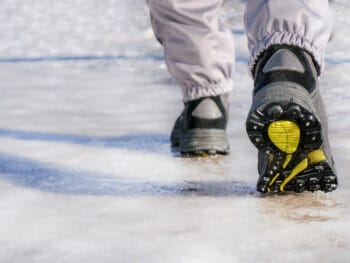
Among those most at risk are construction workers, recreational workers, snow cleanup crews, emergency responders, transit workers, baggage handlers, and workers in water transportation, landscaping and support activities for oil and gas operations.
Cold stress happens when skin temperature and ultimately the body’s internal temperature are reduced to the point that the body cannot warm itself. Both the air temperature and wind speed can play a part. Permanent tissue damage and death can occur.
Click Link to Access Free PDF Download
“4-Step Sequence For Effective Employee Screening, Hiring, & Placement”
The factors that put workers at an increased risk for cold stress include:
- Wetness, improper clothing, exhaustion.
- Comorbid health conditions such as hypertension, hypothyroidism and diabetes.
- Poor physical shape.
Employers should train workers to understand the types of cold stress, recognize the symptoms and know what to do to prevent it and help those affected. Frequent, short breaks in warm, dry areas go a long way to ensuring workers are not exposed too long. Warm beverages should be provided to outdoor workers, such as coffee or tea. And employees should be instructed to work in pairs rather than alone.
Here’s a look at the most common types of cold stress.
Frostbite.
Caused by the freezing of the skin and tissues, this can cause permanent damage and even lead to amputation. Symptoms include reddened skin that develops gray-white patches, especially in the fingers, toes, nose or ear lobes. The person may feel tingling, aching or a loss of feeling, and may develop blisters. People with reduced blood circulation and/or those not dressed adequately for cold temperatures are more susceptible to frostbite.
The affected area should be wrapped loosely in a dry cloth until medical help arrives, and the worker should be given warm, sweetened drinks. Anyone helping a worker with frostbite should be instructed not to rub the affected area, apply snow or water, or try to rewarm the area. A frostbitten area that is rewarmed and becomes frozen again can cause additional tissue damage.
Immersion/Trench Foot.
Prolonged exposure to wet and cold conditions can lead to trench foot, even in temperatures as high as 60 degrees. Wet feet lose heat 25 times faster than dry feet. Symptoms include reddening skin, tingling, pain, swelling, leg cramps, numbness and blisters.
The worker’s wet shoes and socks should be removed, and the feet should be dried and elevated until medical help is available.
Hypothermia.
Also called abnormally low body temperature, this occurs when the body temperature drops to less than 95 degrees. It generally occurs at very cold temperatures, but can affect someone in temperatures above 40 degrees if the worker is chilled from rain, sweat or immersion in cold water.
Uncontrollable shivering is one of the more mild symptoms. More severe ones are loss of coordination, confusion, slurred speech, slow heart rate and breathing, and unconsciousness. A body temperature that is too low affects the brain and the person may be unaware that anything is wrong.
First aid remedies call for alerting medical emergency workers immediately. Until help arrives, coworkers are advised to move the worker to a warm, dry area; remove and replace wet clothing; and wrap the entire body in layers of blankets. Warm bottles or hot packs can be placed in the armpits, sides of the chest and groin.
Conclusion
Employers can help keep these workers safe and healthy by providing heaters at worksites, allowing employees to take breaks to warm up, and offering warm beverages. Simple steps such as these can greatly reduce winter-related workers’ comp costs.
For additional information on workers’ compensation cost containment best practices, register as a guest for our next live stream training.

Author Michael Stack, Principal, COMPClub, Amaxx LLC. He is an expert in workers compensation cost containment systems and helps employers reduce their work comp costs by 20% to 50%. He works as a consultant to large and mid-market clients, is co-author of Your Ultimate Guide To Mastering Workers Comp Costs, a comprehensive step-by-step manual of cost containment strategies based on hands-on field experience, and is founder of COMPClub, an exclusive member training program on workers compensation cost containment best practices.
Contact: mstack@reduceyourworkerscomp.com.
Workers’ Comp Roundup Blog: https://blog.reduceyourworkerscomp.com/
Live Stream WC Training: http://workerscompclub.com/livestreamtraining.com
©2017 Amaxx LLC. All rights reserved under International Copyright Law.
Do not use this information without independent verification. All state laws vary. You should consult with your insurance broker, attorney, or qualified professional.














